Queens
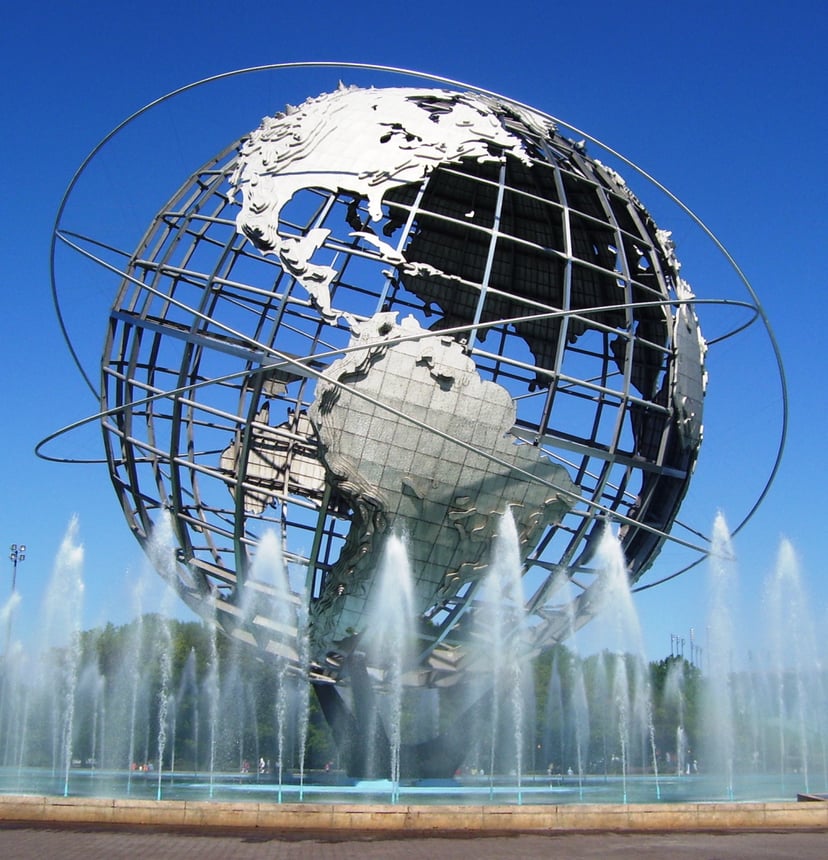
Queens

Queens Queens County, New York | |
|---|---|
Borough and county | |
Clockwise from top: Unisphere; Flushing-bound 7 train;
US Open's Billie Jean King National Tennis Center; New York Mets at Citi Field; Rockaway Park beach; Queensboro Bridge; and AirTrain JFK at John F. Kennedy International Airport | |
 Interactive map outlining Queens | |
| Coordinates:40°45′N 73°52′W [219] | |
| Country | |
| State | |
| County | Queens (coterminous) |
| City | New York City |
| Settled | 1683 |
| Named for | Catherine of Braganza |
| Government | |
| • Type | Borough (New York City) |
| • Borough President | Melinda Katz (D) — (Borough of Queens) |
| • District Attorney (Acting) | John M. Ryan (I) — (Queens County) |
| Area | |
| • Total | 178 sq mi (460 km2) |
| • Land | 109 sq mi (280 km2) |
| • Water | 70 sq mi (200 km2) 39% |
| Population (2017) | |
| • Total | 2,358,582[2] |
| • Density | 21,638.4/sq mi (8,354.6/km2) |
| ZIP Code prefixes | 110--, 111--, 113--, 114--, 116-- |
| Area codes | 718/347/929 and 917 |
| GDP (2015) | US$74 billion[3] |
| Website | Official Website of the Queens Borough President [220] |
Queens is a borough of New York City, coterminous with Queens County, in the U.S. state of New York. It is the largest borough geographically and is adjacent to the borough of Brooklyn at the southwestern end of Long Island. To its east is Nassau County. Queens also shares water borders with the boroughs of Manhattan and the Bronx. The borough of Queens is the second largest in population (after Brooklyn), with an estimated 2,358,582 residents in 2017,[2] approximately 48 percent of them foreign-born.[4] Queens County also is the second most populous county in the U.S. state of New York, behind Brooklyn, which is coterminous with Kings County. Queens is the fourth most densely populated county among New York City's boroughs, as well as in the United States. If each of New York City's boroughs were an independent city, Queens would be the nation's fourth most populous, after Los Angeles, Chicago, and Brooklyn.[5] Queens is the most ethnically diverse urban area in the world.[6]
Queens was established in 1683 as one of the original 12 counties of New York. The settlement was presumably named for the English queen Catherine of Braganza (1638–1705).[7] Queens became a borough during the consolidation of New York City in 1898, and from 1683 until 1899, the County of Queens included what is now Nassau County.
Queens has the most diversified economy of the five boroughs of New York City.[8] It is home to John F. Kennedy International Airport and LaGuardia Airport, both among the world's busiest, which in turn makes the airspace above Queens among the busiest in the United States. Landmarks in Queens include Flushing Meadows–Corona Park; Citi Field, home to the New York Mets baseball team; the USTA Billie Jean King National Tennis Center, site of the US Open tennis tournament; Kaufman Astoria Studios; Silvercup Studios; and Aqueduct Racetrack. The borough has diverse housing, ranging from high-rise apartment buildings in the urban areas of western and central Queens, such as Ozone Park, Jackson Heights, Flushing, Astoria, and Long Island City, to somewhat more suburban neighborhoods in the eastern part of the borough, including Douglaston–Little Neck and Bayside.[9][10] The Queens Night Market in Flushing Meadows-Corona Park attracts over 10,000 people nightly to sample food from over 85 countries.[11]
Queens Queens County, New York | |
|---|---|
Borough and county | |
Clockwise from top: Unisphere; Flushing-bound 7 train;
US Open's Billie Jean King National Tennis Center; New York Mets at Citi Field; Rockaway Park beach; Queensboro Bridge; and AirTrain JFK at John F. Kennedy International Airport | |
 Interactive map outlining Queens | |
| Coordinates:40°45′N 73°52′W [219] | |
| Country | |
| State | |
| County | Queens (coterminous) |
| City | New York City |
| Settled | 1683 |
| Named for | Catherine of Braganza |
| Government | |
| • Type | Borough (New York City) |
| • Borough President | Melinda Katz (D) — (Borough of Queens) |
| • District Attorney (Acting) | John M. Ryan (I) — (Queens County) |
| Area | |
| • Total | 178 sq mi (460 km2) |
| • Land | 109 sq mi (280 km2) |
| • Water | 70 sq mi (200 km2) 39% |
| Population (2017) | |
| • Total | 2,358,582[2] |
| • Density | 21,638.4/sq mi (8,354.6/km2) |
| ZIP Code prefixes | 110--, 111--, 113--, 114--, 116-- |
| Area codes | 718/347/929 and 917 |
| GDP (2015) | US$74 billion[3] |
| Website | Official Website of the Queens Borough President [220] |
History
Colonial and post-colonial history

Catherine of Braganza, former Queen of England
European colonization brought Dutch and English settlers, as a part of the New Netherland colony. First settlements occurred in 1635 followed by early colonizations at Maspeth in 1642,[12] and Vlissingen (now Flushing) in 1643.[13] Other early settlements included Newtown (now Elmhurst) and Jamaica. However, these towns were mostly inhabited by English settlers from New England via eastern Long Island (Suffolk County) subject to Dutch law.[14] After the capture of the colony by the English and its renaming as New York in 1664, the area (and all of Long Island) became known as Yorkshire.
The Flushing Remonstrance signed by colonists in 1657 is considered a precursor to the United States Constitution's provision on freedom of religion in the Bill of Rights. The signers protested the Dutch colonial authorities' persecution of Quakers in what is today the borough of Queens.
Originally, Queens County included the adjacent area now comprising Nassau County. It was an original county of New York State, one of twelve created on November 1, 1683.[15] The county is assumed to have been named after Catherine of Braganza, since she was queen of England at the time (she was Portugal's royal princess Catarina daughter of King John IV of Portugal).[7] The county was founded alongside Kings County (Brooklyn, which was named after her husband, King Charles II), and Richmond County (Staten Island, named after his illegitimate son, the 1st Duke of Richmond).[16][17][18] However, the namesake is in dispute; while Catherine's title seems the most likely namesake, no historical evidence of official declaration has been found.[19] On October 7, 1691, all counties in the Colony of New York were redefined. Queens gained North and South Brother Islands as well as Huletts Island (today known as Rikers Island).[20] On December 3, 1768, Queens gained other islands in Long Island Sound that were not already assigned to a county but that did not abut on Westchester County (today's Bronx County).[21]
Queens played a minor role in the American Revolution, as compared to Brooklyn, where the Battle of Long Island was largely fought. Queens, like the rest of what became New York City and Long Island, remained under British occupation after the Battle of Long Island in 1776 and was occupied throughout most of the rest of the Revolutionary War. Under the Quartering Act, British soldiers used, as barracks, the public inns and uninhabited buildings belonging to Queens residents. Even though many local people were against unannounced quartering, sentiment throughout the county remained in favor of the British crown. The quartering of soldiers in private homes, except in times of war, was banned by the Third Amendment to the United States Constitution. Nathan Hale was captured by the British on the shore of Flushing Bay in Queens before being executed by hanging in Manhattan for gathering intelligence.
From 1683 until 1784, Queens County consisted of five towns: Flushing, Hempstead, Jamaica, Newtown, and Oyster Bay. On April 6, 1784, a sixth town, the Town of North Hempstead, was formed through secession by the northern portions of the Town of Hempstead.[22][23] The seat of the county government was located first in Jamaica,[24] but the courthouse was torn down by the British during the American Revolution to use the materials to build barracks.[25] After the war, various buildings in Jamaica temporarily served as courthouse and jail until a new building was erected about 1787 (and later completed) in an area near Mineola (now in Nassau County) known then as Clowesville.[26][27][28][29][30][31][32][33][34][35][36][37][38][39][40][41][42]
The 1850 United States Census was the first in which the population of the three western towns exceeded that of the three eastern towns that are now part of Nassau County. Concerns were raised about the condition and distance of the old courthouse, and several sites were in contention for the construction of a new one.[43]
In 1870, Long Island City split from the Town of Newtown, incorporating itself as a city, consisting of what had been the Village of Astoria and some unincorporated areas within the Town of Newtown. Around 1874, the seat of county government was moved to Long Island City from Mineola.[39][44][45][46]
On March 1, 1860, the eastern border between Queens County (later Nassau County) and Suffolk County was redefined with no discernible change.[47] On June 8, 1881, North Brother Island was transferred to New York County.[48] On May 8, 1884, Rikers Island was transferred to New York County.[49]
In 1885, Lloyd Neck, which was part of the Town of Oyster Bay and was earlier known as Queens Village, seceded from Queens and became part of the Town of Huntington in Suffolk County.[50][51] On April 16, 1964, South Brother Island was transferred to Bronx County.[52]
Incorporation as borough
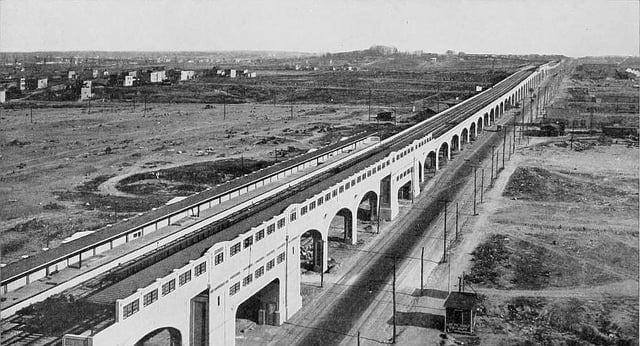
Queens Boulevard, looking east from Van Dam Street, in 1920. The newly built IRT Flushing Line is in the boulevard's median.
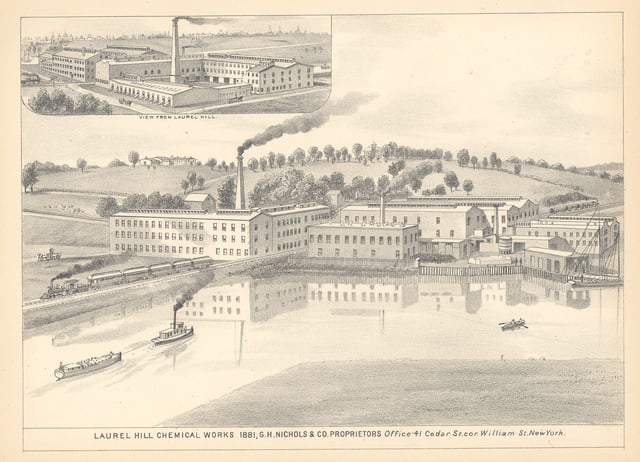
Laurel Hill Chemical Works, 1883. Parts of Queens were becoming industrial suburbs

Looking south from the Queensboro Bridge in Long Island City, this photo was published in 1920 by the Queens Chamber of Commerce to illustrate the borough's "numerous attractive industrial plants".[70]
"The city of Long Island City, the towns of Newtown, Flushing and Jamaica, and that part of the town of Hempstead, in the county of Queens, which is westerly of a straight line drawn through the middle of the channel between Rockaway Beach and Shelter Island, in the county of Queens, to the Atlantic Ocean" was annexed to New York City,[58] dissolving all former municipal governments (Long Island City, the county government, all towns, and all villages) within the new borough.[59] The areas of Queens County that were not part of the consolidation plan,[45][60][61][62][63][64][65] consisting of the towns of North Hempstead and Oyster Bay, and the major remaining portion of the Town of Hempstead, remained part of Queens County until they seceded to form the new Nassau County on January 1, 1899. At this point, the boundaries of Queens County and the Borough of Queens became coterminous. With consolidation, Jamaica once again became the county seat, though county offices now extend to nearby Kew Gardens also.[66]
The borough's administrative and court buildings are presently located in Kew Gardens and downtown Jamaica respectively, two neighborhoods that were villages of the former Town of Jamaica.
From 1905 to 1908 the Long Island Rail Road in Queens became electrified. Transportation to and from Manhattan, previously by ferry or via bridges in Brooklyn, opened up with the Queensboro Bridge finished in 1909, and with railway tunnels under the East River in 1910. From 1915 onward, much of Queens was connected to the New York City Subway system.[67][68] With the 1915 construction of the Steinway Tunnel carrying the IRT Flushing Line between Queens and Manhattan, and the robust expansion of the use of the automobile, the population of Queens more than doubled in the 1920s, from 469,042 in 1920 to 1,079,129 in 1930.[69]
In later years, Queens was the site of the 1939 New York World's Fair and the 1964 New York World's Fair. LaGuardia Airport, in northern Queens, opened in 1939. Idlewild Airport, in southern Queens and now called JFK Airport, opened in 1948. American Airlines Flight 587 took off from the latter airport on November 12, 2001, but ended up crashing in Queens' Belle Harbor area, killing 265 people. In late October 2012, much of Queens' Breezy Point area was destroyed by a massive six-alarm fire caused by Hurricane Sandy.
Boroughscape
Geography

Location of Queens (red) within New York City (remainder white)
Queens is located on the far western portion of geographic Long Island and includes a few smaller islands, most of which are in Jamaica Bay, forming part of the Gateway National Recreation Area, which in turn is one of the National Parks of New York Harbor.[71] According to the United States Census Bureau, Queens County has a total area of 178 square miles (460 km2), of which 109 square miles (280 km2) is land and 70 square miles (180 km2) (39%) is water.[72]
Brooklyn, the only other New York City borough on geographic Long Island, lies just south and west of Queens, with Newtown Creek, an estuary that flows into the East River, forming part of the border. To the west and north is the East River, across which is Manhattan to the west and The Bronx to the north. Nassau County is east of Queens on Long Island. Staten Island is southwest of Brooklyn, and shares only a 3-mile-long water border (in the Outer Bay) with Queens. North of Queens are Flushing Bay and the Flushing River, connecting to the East River. The East River opens into Long Island Sound. The midsection of Queens is crossed by the Long Island straddling terminal moraine created by the Wisconsin Glacier. The Rockaway Peninsula, the southernmost part of all of Long Island, sits between Jamaica Bay and the Atlantic Ocean, featuring 7 miles (11 km) of beaches.[73][74][75]
Climate

NASA Landsat satellite image of Long Island and surrounding areas
Under the Köppen climate classification, using the 32 °F (0 °C) coldest month (January) isotherm, Queens and the rest of New York City have a humid subtropical climate (Cfa) with partial shielding from the Appalachian Mountains and moderating influences from the Atlantic Ocean. Queens receives precipitation throughout the year, with an average of 44.8 inches (114 cm) per year. In an average year, there will be 44 days with either moderate or heavy rain.[76]
An average winter will have 22 days with some snowfall, of which 9 days have at least 1 inch (2.5 cm) of snowfall.[76] Summer is typically hot, humid, and wet. An average year will have 17 days with a high temperature of 90 °F (32 °C) or warmer.[76] In an average year, there are 14 days where the temperature does not go above 32 °F (0 °C) all day.[76] Spring and autumn can vary from chilly to very warm.
The highest temperature ever recorded at LaGuardia Airport was 107 °F (42 °C) on July 3, 1966.[77][76] The highest temperature ever recorded at John F. Kennedy International Airport was 104 °F (40 °C), also on July 3, 1966.[77][78] LaGuardia Airport's record-low temperature was −7 °F (−22 °C) on February 15, 1943, the effect of which was exacerbated by a shortage of heating oil and coal.[76][79] John F. Kennedy International Airport's record-low temperature was −2 °F (−19 °C), on February 8, 1963, and January 21, 1985.[78][80][81] On January 24, 2016, 30.5 inches (77 cm) of snow fell, which is the record in Queens.[82]
Tornadoes are generally rare; the most recent tornado, an EF0, touched down in College Point on August 3, 2018, causing minor damage.[83] Prior to that, there was a tornado in Breezy Point on September 8, 2012, which damaged the roofs of some homes,[84] and an EF1 tornado in Flushing on September 26, 2010.[85]
| Monthly and annual statistics for the two main climatology stations in Queens | ||||||||||||||||||||||||||||||||||||||||||||||||||||||||||||||||||||||||||||||||||||||||||||||||||||||||||||||||||||||||||||||||||||||||||||||||||||||||||||||||||||||||||||||||||||||||||||||||||||||||||||||||||||||||||||||||||||||||||||||||||||||||||||||||||||||||||||||||||||||||||||||||||||||||||||||||||||||||||||||||||||||||||||||||||||||||||||||||||||||||||||||||||||||||||||||||||||||||
|---|---|---|---|---|---|---|---|---|---|---|---|---|---|---|---|---|---|---|---|---|---|---|---|---|---|---|---|---|---|---|---|---|---|---|---|---|---|---|---|---|---|---|---|---|---|---|---|---|---|---|---|---|---|---|---|---|---|---|---|---|---|---|---|---|---|---|---|---|---|---|---|---|---|---|---|---|---|---|---|---|---|---|---|---|---|---|---|---|---|---|---|---|---|---|---|---|---|---|---|---|---|---|---|---|---|---|---|---|---|---|---|---|---|---|---|---|---|---|---|---|---|---|---|---|---|---|---|---|---|---|---|---|---|---|---|---|---|---|---|---|---|---|---|---|---|---|---|---|---|---|---|---|---|---|---|---|---|---|---|---|---|---|---|---|---|---|---|---|---|---|---|---|---|---|---|---|---|---|---|---|---|---|---|---|---|---|---|---|---|---|---|---|---|---|---|---|---|---|---|---|---|---|---|---|---|---|---|---|---|---|---|---|---|---|---|---|---|---|---|---|---|---|---|---|---|---|---|---|---|---|---|---|---|---|---|---|---|---|---|---|---|---|---|---|---|---|---|---|---|---|---|---|---|---|---|---|---|---|---|---|---|---|---|---|---|---|---|---|---|---|---|---|---|---|---|---|---|---|---|---|---|---|---|---|---|---|---|---|---|---|---|---|---|---|---|---|---|---|---|---|---|---|---|---|---|---|---|---|---|---|---|---|---|---|---|---|---|---|---|---|---|---|---|---|---|---|---|---|---|---|---|---|---|---|---|---|---|---|---|---|---|---|---|---|---|---|---|---|---|---|---|---|---|---|---|---|---|---|---|---|---|---|---|---|---|---|---|---|---|---|---|---|---|---|---|---|---|---|---|---|---|---|---|---|---|---|---|---|---|---|---|---|
| ||||||||||||||||||||||||||||||||||||||||||||||||||||||||||||||||||||||||||||||||||||||||||||||||||||||||||||||||||||||||||||||||||||||||||||||||||||||||||||||||||||||||||||||||||||||||||||||||||||||||||||||||||||||||||||||||||||||||||||||||||||||||||||||||||||||||||||||||||||||||||||||||||||||||||||||||||||||||||||||||||||||||||||||||||||||||||||||||||||||||||||||||||||||||||||||||||||||||
Neighborhoods
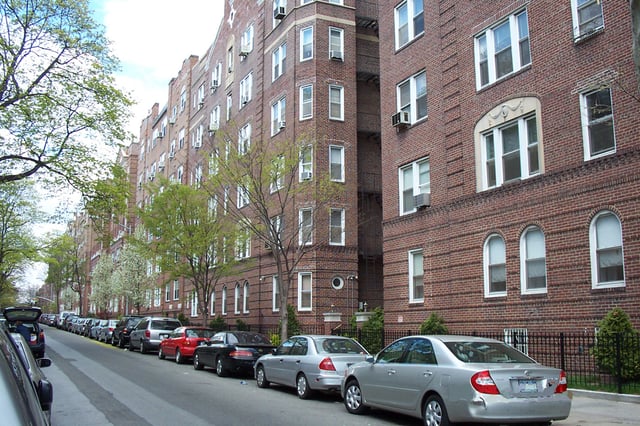
A typical residential street in Jackson Heights
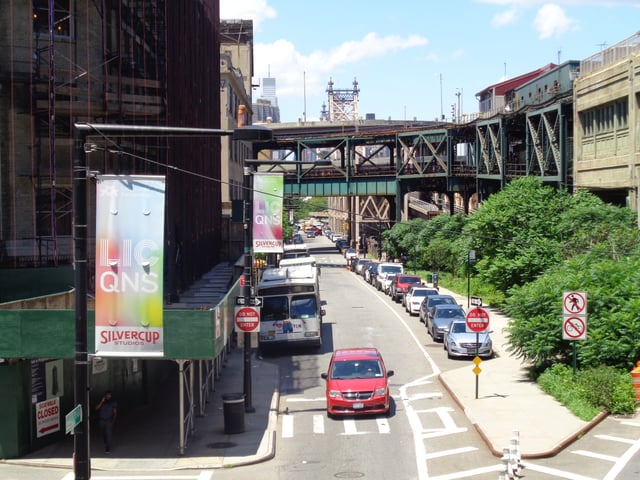
Long Island City, a neighborhood in western Queens
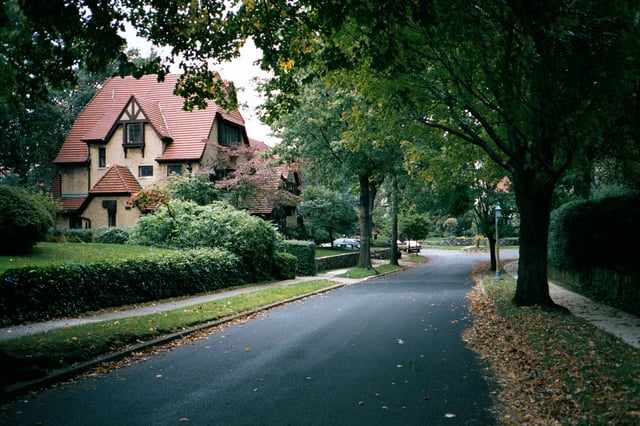
Forest Hills Gardens
Four United States Postal Service postal zones serve Queens, based roughly on those serving the towns in existence at the consolidation of the five boroughs into New York City: Long Island City (ZIP codes starting with 111), Jamaica (114), Flushing (113), and Far Rockaway (116). In addition, the Floral Park post office (110), based in Nassau County, serves a small part of northeastern Queens. Each of these main post offices have neighborhood stations with individual ZIP codes, and unlike the other boroughs, these station names are often used in addressing letters. These ZIP codes do not always reflect traditional neighborhood names and boundaries; "East Elmhurst", for example, was largely coined by the USPS and is not an official community. Most neighborhoods have no solid boundaries. The Forest Hills and Rego Park neighborhoods, for instance, overlap.
Residents of Queens often closely identify with their neighborhood rather than with the borough or city. The borough is a patchwork of dozens of unique neighborhoods, each with its own distinct identity:
Flushing, one of the largest neighborhoods in Queens, has a large and growing Asian community. The community consists of Chinese, Koreans, and South Asians. Asians have now expanded eastward along the Northern Boulevard axis through Murray Hill, Whitestone, Bayside, Douglaston–Little Neck, and eventually into adjacent Nassau County.[91][92] These neighborhoods historically contained Italian Americans and Greeks, as well as Latino Americans. The busy intersection of Main Street, Kissena Boulevard, and 41st Avenue defines the center of Downtown Flushing and the Flushing Chinatown (法拉盛華埠), known as the "Chinese Times Square" or the "Chinese Manhattan".[93][94] The segment of Main Street between Kissena Boulevard and Roosevelt Avenue, punctuated by the Long Island Rail Road trestle overpass, represents the cultural heart of the Flushing Chinatown. Housing over 30,000 individuals born in China alone, the largest by this metric outside Asia, Flushing has become home to the largest and one of the fastest-growing Chinatowns in the world as the heart of over 250,000 ethnic Chinese in Queens, representing the largest Chinese population of any U.S. municipality other than New York City in total.[95] Conversely, the Flushing Chinatown has also become the epicenter of organized prostitution in the United States, importing women from China, Korea, Thailand, and Eastern Europe to sustain the underground North American sex trade.[96]
Howard Beach, Whitestone, and Middle Village are home to large Italian American populations.
Ozone Park and South Ozone Park have large Italian, Hispanic, and Guyanese populations.
Rockaway Beach has a large Irish American population.
Astoria, in the northwest, is traditionally home to one of the largest Greek populations outside Greece, it also has large Spanish American, Albanian American, Bosnian American, Bulgarian American, Croatian American, Romanian American and Italian American communities, and is also home to a growing population of Arabs, South Asians, and young professionals from Manhattan. Nearby Long Island City is a major commercial center and the home to Queensbridge, the largest housing project in North America.
Maspeth and Ridgewood are home to many Eastern European immigrants such as Romanian, Polish, Serbian, Albanian, and other Slavic populations. Ridgewood also has a large Hispanic population.
Jackson Heights, Elmhurst, and East Elmhurst make up an conglomeration of Hispanic, Asian, Tibetan, and South Asian communities.
Woodside is home to a large Filipino American community and has a "Little Manila" as well a large Irish American population. There is also a large presence of Filipino Americans in Queens Village and in Hollis.
Richmond Hill, in the south, is often thought of as "Little Guyana" for its large Guyanese community.[97]
Rego Park, Forest Hills, Kew Gardens, and Kew Gardens Hills have traditionally large Jewish populations (historically from Germany and eastern Europe; though more recent immigrants are from Israel, Iran, and the former Soviet Union). These neighborhoods are also known for large and growing Asian communities, mainly immigrants from China.
Jamaica Estates, Jamaica Hills, Hillcrest, Fresh Meadows, and Hollis Hills are also populated with many people of Jewish background. Many Asian families reside in parts of Fresh Meadows as well.
Jamaica is home to large African American and Caribbean populations. There are also middle-class African American and Caribbean neighborhoods such as Saint Albans, Queens Village, Cambria Heights, Springfield Gardens, Rosedale, Laurelton, and Briarwood along east and southeast Queens.
Bellerose and Floral Park, originally home to many Irish Americans, is home to a growing South Asian population, predominantly Indian Americans.
Corona and Corona Heights, once considered the "Little Italy" of Queens, was a predominantly Italian community with a strong African American community in the northern portion of Corona and adjacent East Elmhurst. From the 1920s through the 1960s, Corona remained a close-knit neighborhood. Corona today has the highest concentration of Latinos of any Queens neighborhood, with an increasing Chinese American population, located between Elmhurst and Flushing.[98]
Demographics
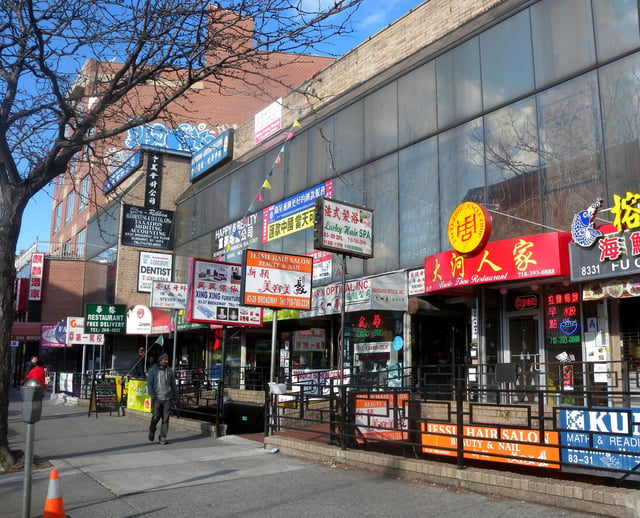
The Elmhurst Chinatown (艾姆赫斯特 唐人街) at the corner of Broadway and Dongan Avenue.
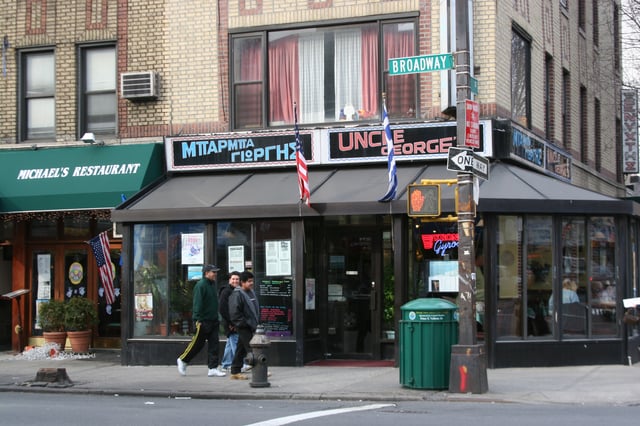
Street scene in Astoria, a largely Greek-American neighborhood.
| Historical population | |||
|---|---|---|---|
| Census | Pop. | %± | |
| 1790 | 6,159 | — | |
| 1800 | 6,642 | 7.8% | |
| 1810 | 7,444 | 12.1% | |
| 1820 | 8,246 | 10.8% | |
| 1830 | 9,049 | 9.7% | |
| 1840 | 14,480 | 60.0% | |
| 1850 | 18,593 | 28.4% | |
| 1860 | 32,903 | 77.0% | |
| 1870 | 45,468 | 38.2% | |
| 1880 | 56,559 | 24.4% | |
| 1890 | 87,050 | 53.9% | |
| 1900 | 152,999 | 75.8% | |
| 1910 | 284,041 | 85.6% | |
| 1920 | 469,042 | 65.1% | |
| 1930 | 1,079,129 | 130.1% | |
| 1940 | 1,297,634 | 20.2% | |
| 1950 | 1,550,849 | 19.5% | |
| 1960 | 1,809,578 | 16.7% | |
| 1970 | 1,986,473 | 9.8% | |
| 1980 | 1,891,325 | −4.8% | |
| 1990 | 1,951,598 | 3.2% | |
| 2000 | 2,229,379 | 14.2% | |
| 2010 | 2,230,722 | 0.1% | |
| Est. 2017 | 2,358,582 | [2] | 5.7% |
| U.S. Decennial Census[99] 1790-1960[100] 1900-1990[101] 1990-2000[102] 2010 and 2017[4] | |||
2010 U.S. Census
In the 2010 United States Census, Queens recorded a population of 2,230,722. There were 780,117 households enumerated, with an average of 2.82 persons per household. The population density was 20,465.3 inhabitants per square mile (7,966.9/km2). There were 835,127 housing units at an average density of 7,661.7 per square mile (2,982.6/km2). The racial makeup of the county was 39.7% White, 19.1% Black or African American, 0.7% Native American, 22.9% Asian, 0.1% Pacific Islander, 12.9% from other races, and 4.5% from two or more races. 27.5% of the population were Hispanic or Latino of any race. The non-Hispanic/Latino white population was 27.6%.[104]
The New York City Department of City Planning was alarmed by the negligible reported increase in population between 2000 and 2010. Areas with high proportions of immigrants and undocumented aliens are traditionally undercounted for a variety of reasons, often based on a mistrust of government officials or an unwillingness to be identified. In many cases, counts of vacant apartment units did not match data from local surveys and reports from property owners.[107]
Population estimates since 2010
As of 2017, the population of Queens was estimated by the United States Census Bureau to have increased to 2,358,582, a rise of 5.7%. Queens' estimated population represented 27.4% of New York City's population of 8,622,698; 30.0% of Long Island's population of 7,869,820; and 11.9% of New York State's population of 19,849,399.[4][108][109][110][111]
Ethnic groups
According to a 2001 Claritas study, Queens was the most diverse county in the United States among counties of 100,000+ population.[113] A 2014 analysis by The Atlantic found Queens County to be the 3rd most racially diverse county-equivalent in the United States—behind Aleutians West Census Area and Aleutians East Borough in Alaska—as well as the most diverse county in New York.[114] In Queens, approximately 48.5% of the population was foreign born as of 2010. Within the foreign born population, 49.5% were born in Latin America, 33.5% in Asia, 14.8% in Europe, 1.8% in Africa, and 0.4% in North America. Roughly 2.1% of the population was born in Puerto Rico, a U.S. territory, or abroad to American parents. In addition, 51.2% of the population was born in the United States. Approximately 44.2% of the population over 5 years of age speak English at home; 23.8% speak Spanish at home. Also, 16.8% of the populace speak other Indo-European languages at home. Another 13.5% speak a non-Indo-European Asian language or language of the Pacific Islands at home.[115]
Among the Asian population, people of Chinese ethnicity make up the largest ethnic group at 10.2% of Queens' population, with about 237,484 people; the other East and Southeast Asian groups are: Koreans (2.9%), Filipinos (1.7%), Japanese (0.3%), Thais (0.2%), Vietnamese (0.2%), and Indonesians and Burmese both make up 0.1% of the population.[112] People of South Asian descent make up 7.8% of Queens' population: Indians (5.3%), Bangladeshi (1.5%), Pakistanis (0.7%), and Nepali (0.2%).[112]
Among the Hispanic population, Puerto Ricans make up the largest ethnic group at 4.6%, next to Mexicans, who make up 4.2% of the population, and Dominicans at 3.9%. Central Americans make up 2.4% and are mostly Salvadorans. South Americans constitute 9.6% of Queens's population, mainly of Ecuadorian (4.4%) and Colombian descent (3.2%).[112]
Some main European ancestries in Queens as of 2000 include:
Italian: 8.4%
Irish: 5.5%
German: 3.5%
Polish: 2.7%
Russian: 2.3%
Greek: 2.0%
The Hispanic or Latino population increased by 61% to 597,773 between 1990 and 2006 and now accounts for 26.5% of the borough's population. Queens is now home to hundreds of thousands of Latinos and Hispanics:
Queens has the largest Colombian population in the city, accounting for 76.6% of the city's total Colombian population, for a total of 80,116.
Queens has the largest Ecuadorian population in the city, accounting for 62.2% of the city's total Ecuadorian population, for a total of 101,339.
Queens has the largest Peruvian population in the city, accounting for 69.9% of the city's total Peruvian population, for a total of 30,825.
Queens has the largest Salvadoran population in the city, accounting for 50.7% of the city's for a total population of 25,235.
The Mexican population in Queens has increased 45.7% to 71,283, the second highest in the city, after Brooklyn.[116]
Queens is home to 49.6% of the city's Asian population. Among the five boroughs, Queens has the largest population of Chinese, Indian, Korean, Filipino, Bangladeshi and Pakistani Americans. Queens has the largest Asian American population by county outside the Western United States; according to the 2006 American Community Survey, Queens ranks fifth among US counties with 477,772 (21.18%) Asian Americans, behind Los Angeles County, California, Honolulu County, Hawaii, Santa Clara County, California, and Orange County, California.
The borough is also home to one of the highest concentrations of Indian Americans in the nation, with an estimated population of 144,896 in 2014 (6.24% of the 2014 borough population),[117] as well as Pakistani Americans, who number at 15,604.[118] Queens has the second largest Sikh population in the nation after California.[119]
In 2010, Queens held a disproportionate share of several Asian communities within New York City, relative to its overall population, as follows:[120]
Chinese: 200,205; 39.8% of the city's total Chinese population.
Indian: 117,550; 64% Asian Indian population.
Korean: 64,107; 66.4% of the city's total Korean population.
Filipino: 38,163; 61.3% of the city's total Filipino population.
Bangladeshi: 18,310; 66% of the city's total Bangladeshi population.
Pakistani: 10,884; 39.5% of the city's total Pakistani population.
The Jewish Community Study of New York 2011, sponsored by the UJA-Federation of New York, found that about 9% of Queens residents were Jews.[122] In 2011, there were about 198,000 Jews in Queens, making it home to about 13% of all people in Jewish households in the eight-county area consisting of the Five Boroughs and Westchester, Nassau, and Suffolk counties.[123] Russian-speaking Jews make up 28% of the Jewish population in Queens, the largest in any of the eight counties.[124]
There were 782,664 households out of which 31.5% had children under the age of 18 living with them, 46.9% were married couples living together, 16.0% had a female householder with no husband present, and 31.3% were non-families. 25.6% of all households were made up of individuals and 9.7% had someone living alone who was 65 years of age or older. The average household size was 2.81 and the average family size was 3.39.
In the county, the population was spread out with 22.8% under the age of 18, 9.6% from 18 to 24, 33.1% from 25 to 44, 21.7% from 45 to 64, and 12.7% who were 65 years of age or older. The median age was 35 years. For every 100 females, there were 92.9 males. For every 100 females age 18 and over, there were 89.6 males.
The median income for a household in the county was $37,439, and the median income for a family was $42,608. Males had a median income of $30,576 versus $26,628 for females. The per capita income for the county was $19,222. About 16.9% of families and 24.7% of the population were below the poverty line, including 18.8% of those under age 18 and 13.0% of those age 65 or over. In Queens, the black population earns more than whites on average.[125] Many of these African Americans live in quiet, middle class suburban neighborhoods near the Nassau County border, such as Laurelton and Cambria Heights which have large black populations whose family income is higher than average. The migration of European Americans from parts of Queens has been long ongoing with departures from Ozone Park, Woodhaven, Bellerose, Floral Park, and Flushing (most of the outgoing population has been replaced with Asian Americans). Neighborhoods such as Whitestone, College Point, North Flushing, Auburndale, Bayside, Middle Village, and Douglaston–Little Neck have not had a substantial exodus of white residents, but have seen an increase of Asian population, mostly Chinese and Korean. Queens has experienced a real estate boom making most of its neighborhoods desirable for people who want to reside near Manhattan but in a less urban setting.
Culture
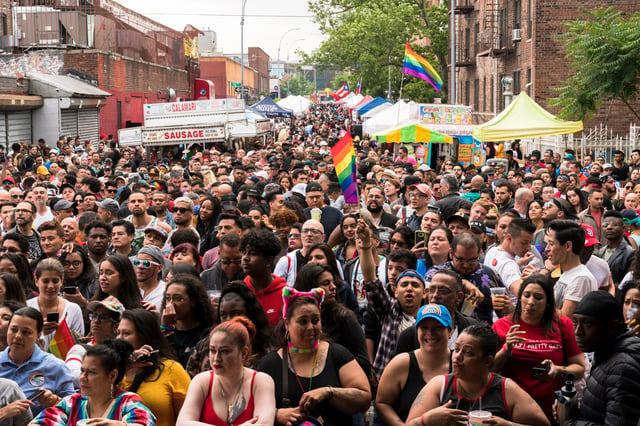
2018 Queens Pride Parade: Caribbean Equality Project at top, and the ensuing Multicultural Festival below.
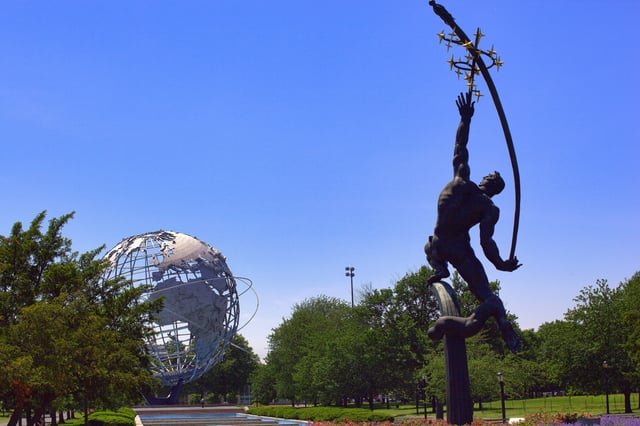
Rocket Thrower (1963) at Flushing Meadows–Corona Park.
Queens has been the center of a major artistic movement in the form of punk rock with The Ramones originating out of Forest Hills,[126] it has also been the home of such notable artists as Tony Bennett, Francis Ford Coppola, Paul Simon, and Robert Mapplethorpe. The current poet laureate of Queens is Paolo Javier.[127]
Queens has notably fostered African-American culture, with establishments such as The Afrikan Poetry Theatre[128] and the Black Spectrum Theater Company[129] catering specifically to African Americans in Queens. In the 1940s, Queens was an important center of jazz; such jazz luminaries as Louis Armstrong, Charlie Parker, and Ella Fitzgerald took up residence in Queens, seeking refuge from the segregation they found elsewhere in New York.[130] Additionally, many notable hip-hop acts hail from Queens, including Action Bronson, Nas, Run-D.M.C., Kool G Rap, A Tribe Called Quest, LL Cool J, Mobb Deep, 50 Cent, Nicki Minaj, and Heems of Das Racist.
Queens hosts various museums and cultural institutions that serve its diverse communities. They range from the historical (such as the John Bowne House) to the scientific (such as the New York Hall of Science), from conventional art galleries (such as the Noguchi Museum) to unique graffiti exhibits (such as 5 Pointz). Queens's cultural institutions include, but are not limited to:
5 Pointz
Afrikan Poetry Theatre
Bowne House
Flushing Town Hall
King Manor
MoMA PS1
Museum of the Moving Image
Noguchi Museum
New York Hall of Science
Queens Botanical Garden
Queens Museum of Art
SculptureCenter
Hindu Temple Society of North America
Jamaica Center for Arts and Learning
The travel magazine Lonely Planet also named Queens the top destination in the country for 2015 for its cultural and culinary diversity.[131] Stating that Queens is "quickly becoming its hippest" but that "most travelers haven’t clued in… yet,"[132] the Lonely Planet stated that "nowhere is the image of New York as the global melting pot truer than Queens."[133]
Languages
There are 138 languages spoken in the borough.[134] As of 2010, 43.84% (905,890) of Queens residents aged five and older spoke only English at home, while 23.88% (493,462) spoke Spanish, 8.06% (166,570) Chinese, 3.44% (71,054) various Indic languages, 2.74% (56,701) Korean, 1.67% (34,596) Russian, 1.56% (32,268) Italian, 1.54% (31,922) Tagalog, 1.53% (31,651) Greek, 1.32% (27,345) French Creole, 1.17% (24,118) Polish, 0.96% (19,868) Hindi, 0.93% (19,262) Urdu, 0.92% (18,931) other Asian languages, 0.80% (16,435) other Indo-European languages, 0.71% (14,685) French, 0.61% (12,505) Arabic, 0.48% (10,008) Serbo-Croatian, and Hebrew was spoken as a main language by 0.46% (9,410) of the population over the age of five. In total, 56.16% (1,160,483) of Queens's population aged five and older spoke a language at home other than English.[135]
Food
The cuisine available in Queens reflects its vast cultural diversity.[136] The cuisine of a particular neighborhood often represents its demographics; for example, Astoria hosts many Greek restaurants, in keeping with its traditionally Greek population.[137] Jackson Heights is known for its prominent Indian cuisine and also many Latin American eateries.
Government
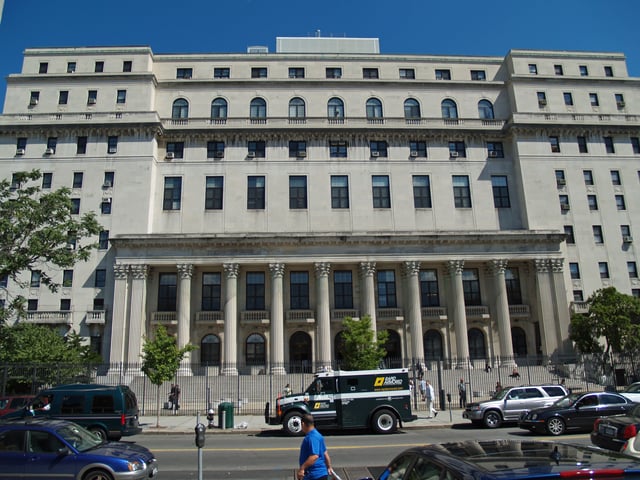
The Queens County Courthouse was built in 1938 and houses the borough's Supreme Court, Surrogate Court and County Clerk.[139]
| Year | Republican | Democratic | Third parties |
|---|---|---|---|
| 2016 | 21.8% 149,341 | 75.4% 517,220 | 2.9% 19,832 |
| 2012 | 19.9% 118,589 | 79.1% 470,732 | 1.0% 5,924 |
| 2008 | 24.3% 155,221 | 75.1% 480,692 | 0.7% 4,224 |
| 2004 | 27.4% 165,954 | 71.7% 433,835 | 0.9% 5,603 |
| 2000 | 22.0% 122,052 | 75.0% 416,967 | 3.1% 16,972 |
| 1996 | 21.1% 107,650 | 72.9% 372,925 | 6.0% 30,721 |
| 1992 | 28.3% 157,561 | 62.9% 349,520 | 8.8% 48,875 |
| 1988 | 39.7% 217,049 | 59.5% 325,147 | 0.8% 4,533 |
| 1984 | 46.4% 285,477 | 53.3% 328,379 | 0.3% 1,722 |
| 1980 | 44.8% 251,333 | 48.0% 269,147 | 7.2% 40,443 |
| 1976 | 39.0% 244,396 | 60.5% 379,907 | 0.5% 3,200 |
| 1972 | 56.3% 426,015 | 43.4% 328,316 | 0.2% 1,756 |
| 1968 | 40.0% 306,620 | 53.6% 410,546 | 6.4% 48,746 |
| 1964 | 33.6% 274,351 | 66.3% 541,418 | 0.1% 1,059 |
| 1960 | 45.1% 367,688 | 54.7% 446,348 | 0.2% 1,863 |
| 1956 | 59.4% 466,057 | 40.6% 318,723 | 0.0% 0 |
| 1952 | 57.1% 450,610 | 42.0% 331,217 | 0.9% 7,194 |
| 1948 | 50.6% 323,459 | 42.0% 268,742 | 7.4% 47,342 |
| 1944 | 55.3% 365,365 | 44.4% 292,940 | 0.3% 2,071 |
| 1940 | 52.7% 323,406 | 46.9% 288,024 | 0.4% 2,524 |
| 1936 | 33.0% 162,797 | 64.9% 320,053 | 2.1% 10,159 |
| 1932 | 34.3% 136,641 | 61.5% 244,740 | 4.2% 16,760 |
| 1928 | 45.9% 158,505 | 53.4% 184,640 | 0.7% 2,411 |
| 1924 | 53.6% 100,793 | 31.0% 58,402 | 15.4% 28,974 |
| 1920 | 68.7% 94,360 | 25.7% 35,296 | 5.6% 7,668 |
| 1916 | 50.5% 34,670 | 45.7% 31,350 | 3.8% 2,575 |
| 1912 | 16.5% 9,201 | 50.3% 28,076 | 33.2% 18,521 |
| 1908 | 44.1% 19,420 | 46.2% 20,342 | 9.7% 4,246 |
| 1904 | 41.4% 14,096 | 53.4% 18,151 | 5.2% 1,770 |
| 1900 | 43.9% 12,323 | 52.6% 14,747 | 3.5% 976 |
| 1896 | 58.0% 18,694 | 37.2% 11,980 | 4.8% 1,539 |
| 1892 | 41.7% 11,704 | 54.2% 15,195 | 4.1% 1,161 |
| 1888 | 46.0% 11,017 | 52.9% 12,683 | 1.2% 275 |
| 1884 | 43.8% 8,445 | 53.8% 10,367 | 2.4% 471 |
| Party | 2005 | 2004 | 2003 | 2002 | 2001 | 2000 | 1999 | 1998 | 1997 | 1996 |
|---|---|---|---|---|---|---|---|---|---|---|
| Democratic | 62.94% | 62.52 | 62.85 | 62.79 | 62.99 | 62.52 | 62.30 | 62.27 | 62.28 | 62.33 |
| Republican | 14.60% | 14.66 | 14.97 | 15.04 | 15.28 | 15.69 | 16.47 | 16.74 | 16.93 | 17.20 |
| Other | 3.88% | 3.93 | 3.94 | 3.86 | 3.37 | 3.30 | 3.10 | 3.20 | 3.02 | 2.78 |
| No affiliation | 18.58% | 18.89 | 18.24 | 18.31 | 18.36 | 18.49 | 18.13 | 17.79 | 17.77 | 17.69 |
Since New York City's consolidation in 1898, Queens has been governed by the New York City Charter that provides for a strong mayor-council system. The centralized New York City government is responsible for public education, correctional institutions, public safety, recreational facilities, sanitation, water supply, and welfare services in Queens. The Queens Library is governed by a 19-member Board of Trustees, who are appointed by the Mayor of New York City and the Borough President of Queens.
Since 1990 the Borough President has acted as an advocate for the borough at the mayoral agencies, the City Council, the New York state government, and corporations. Queens' Borough President is Melinda Katz, elected in November 2013 as a Democrat with 80.3% of the vote. Queens Borough Hall is the seat of government and is located in Kew Gardens.
The Democratic Party holds most public offices. Sixty-three percent of registered Queens voters are Democrats. Local party platforms center on affordable housing, education and economic development. Controversial political issues in Queens include development, noise, and the cost of housing.
Each of the city's five counties has its own criminal court system and District Attorney, the chief public prosecutor who is directly elected by popular vote. Richard A. Brown, who ran on both the Republican and Democratic Party tickets, was the District Attorney of Queens County from 1991-2018. The new DA as of June 2019 is John Ryan.[140] Queens has 12 seats on the New York City Council, the second largest number among the five boroughs. It is divided into 14 community districts, each served by a local Community Board. Community Boards are representative bodies that field complaints and serve as advocates for local residents.
Although Queens is heavily Democratic, it is considered a swing county in New York politics. Republican political candidates who do well in Queens usually win citywide or statewide elections. Republicans such as former Mayors Rudolph Giuliani and Michael Bloomberg won majorities in Queens. Republican State Senator Serphin Maltese represented a district in central and southern Queens for twenty years until his defeat in 2008 by Democratic City Councilman Joseph Addabbo. In 2002, Queens voted against incumbent Republican Governor of New York George Pataki in favor of his Democratic opponent, Carl McCall by a slim margin.[141]
On the national level, Queens has not voted for a Republican candidate in a presidential election since 1972, when Queens voters chose Richard Nixon over George McGovern. Since the 1996 presidential election, Democratic presidential candidates have received over 70% of the popular vote in Queens.[142] Since the election of Donald Trump, Queens has become known in the United States for its surge in progressive politics and grassroots campaigning.[143]
Representatives in the U.S. Congress
In 2018, seven Democrats represented Queens in the United States House of Representatives.[144]
Thomas Suozzi (first elected in 2016) represents New York's 3rd congressional district, which covers the northeast Queens neighborhoods of Little Neck, Whitestone, Glen Oaks, and Floral Park. The district also covers the North Shore of Nassau County.[144]
Gregory Meeks (first elected in 1998) represents New York's 5th congressional district, which covers the entire Rockaway Peninsula as well as the southeast Queens neighborhoods of Broad Channel, Cambria Heights, Hollis, Jamaica, Laurelton, Queens Village, Rosedale, Saint Albans, Springfield Gardens, and South Ozone Park. The district also includes John F. Kennedy International Airport.[144]
Grace Meng (first elected in 2012) represents New York's 6th congressional district, which includes the central and eastern Queens neighborhoods of Auburndale, Bayside, Elmhurst, Flushing, Forest Hills, Glendale, Kew Gardens, Maspeth, Middle Village, Murray Hill, and Rego Park.[144]
Nydia Velázquez (first elected in 1992) represents New York's 7th congressional district, which includes the southwest Queens neighborhoods of Maspeth, Ridgewood, and Woodhaven. The district also covers central and western Brooklyn and the Lower East Side of Manhattan.[144]
Hakeem Jeffries (first elected in 2012) represents New York's 8th congressional district, which includes the southwest Queens neighborhoods of Ozone Park and Howard Beach. The district also covers central and southern Brooklyn.[144]
Carolyn Maloney (first elected in 1992) represents New York's 12th congressional district, which includes the western Queens neighborhoods of Astoria, Long Island City, Sunnyside, and Maspeth. The district also covers the East Side of Manhattan.[144]
Alexandria Ocasio-Cortez (first elected in 2018) represents New York's 14th congressional district, which includes the northwest Queens neighborhoods of Astoria, College Point, Corona, East Elmhurst, Jackson Heights, Woodside, and Elmhurst. The district also covers the East Bronx.[144]
Economy
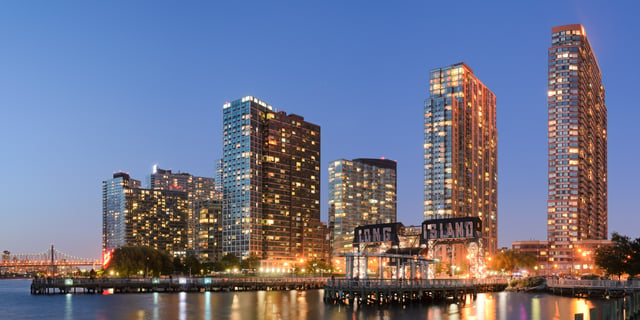
Long Island City is one of New York City's fastest growing neighborhoods.[145]
Queens has the second-largest economy of New York City's five boroughs, following Manhattan. In 2004, Queens had 15.2% (440,310) of all private sector jobs in New York City and 8.8% of private sector wages. Queens has the most diversified economy of the five boroughs, with occupations spread relatively evenly across the health care, retail trade, manufacturing, construction, transportation, and film and television production sectors, such that no single sector is overwhelmingly dominant.[8]
The diversification in Queens' economy is reflected in the large amount of employment in the export-oriented portions of its economy—such as transportation, manufacturing, and business services—that serve customers outside the region. This accounts for more than 27% of all Queens jobs and offers an average salary of $43,727, 14% greater than that of jobs in the locally oriented sector.
The borough's largest employment sector—trade, transportation, and utilities—accounted for nearly 30% of all jobs in 2004. Queens is home to two of the three major New York City area airports, JFK International Airport and LaGuardia Airport. These airports are among the busiest in the world, leading the airspace above Queens to be the most congested in the country. This airline industry is particularly important to the economy of Queens, providing almost one quarter of the sector's employment and more than 30% of the sector's wages.
Education and health services is the next largest sector in Queens and comprised almost 24% of the borough's jobs in 2004. The manufacturing and construction industries in Queens are the largest of the City and account for nearly 17% of the borough's private sector jobs. Comprising almost 17% of the jobs in Queens is the information, financial activities, and business and professional services sectors.
As of 2003, Queens had almost 40,000 business establishments. Small businesses act as an important part of the borough's economic vitality with two thirds of all business employing between one and four people.
Several large companies have their headquarters in Queens, including watchmaker Bulova, based in East Elmhurst; internationally renowned piano manufacturer Steinway & Sons in Astoria; Glacéau, the makers of Vitamin Water, headquartered in Whitestone; and JetBlue Airways, an airline based in Long Island City.
Long Island City is a major manufacturing and back office center. Flushing is a major commercial hub for Chinese American and Korean American businesses, while Jamaica is the major civic and transportation hub for the borough.
Sports

Citi Field, the home of the New York Mets, 2010
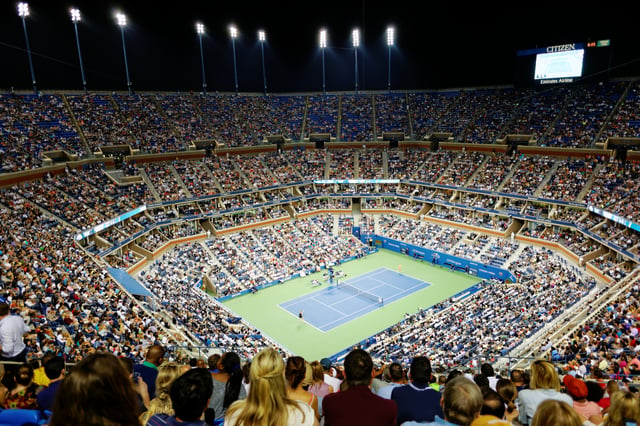
Arthur Ashe Stadium interior, US Open 2014
Citi Field is a 41,922-seat stadium opened in April 2009 in Flushing Meadows–Corona Park that is the home ballpark of the New York Mets of Major League Baseball.[146] Shea Stadium, the former home of the Mets and the New York Jets of the National Football League, as well as the temporary home of the New York Yankees and the New York Giants Football Team stood where Citi Field's parking lot is now located, operating from 1964 to 2008.[147]
The US Open tennis tournament has been played since 1978 at the USTA Billie Jean King National Tennis Center, located just south of Citi Field.[148] With a capacity of 23,771, Arthur Ashe Stadium is the biggest tennis stadium in the world.[149] The US Open was formerly played at the West Side Tennis Club in Forest Hills.[150] South Ozone Park is the home of Aqueduct Racetrack, which is operated by the New York Racing Association and offers Thoroughbred horse-racing from late October/early November through April.[151] Belmont Park Racetrack is mostly in Nassau County, New York however a section of the property including the Belmont Park station on the Long Island Rail Road is in Queens.
Transportation
According to the 2010 Census, 36% of all Queens households did not own a car; the citywide rate is 53%. Therefore, mass transit is also used.[152]
Airports
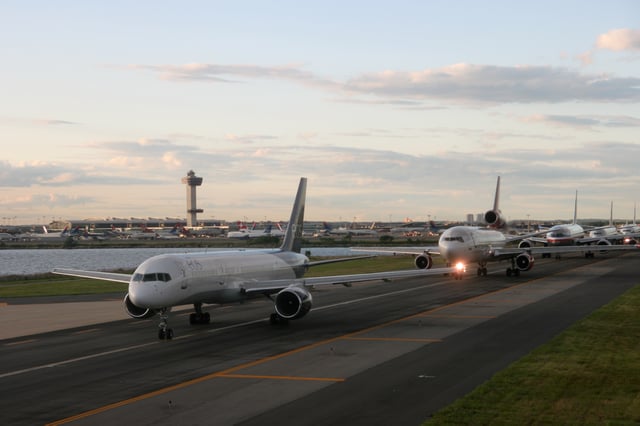
John F. Kennedy Airport in Queens, the busiest international air passenger gateway to the United States.

A multibillion-dollar reconstruction of LaGuardia Airport was announced in July 2015.[156]
Queens has crucial importance in international and interstate air traffic, with two of the New York metropolitan area's three major airports located there.
John F. Kennedy International Airport, with 27.4 million international passengers in 2014 (of 53.2 million passengers, overall), is the busiest airport in the United States by international passenger traffic.[153] Owned by the City of New York and managed since 1947 by the Port Authority of New York and New Jersey, the airport's runways and six terminals cover an area of 4,930 acres (2,000 ha) on Jamaica Bay in southeastern Queens.[154] The airport's original official name was New York International Airport, although it was commonly known as Idlewild, with the name changed to Kennedy in December 1963 to honor the recently assassinated president.[155]
LaGuardia Airport is located in Flushing, in northern Queens, on Flushing Bay. Originally opened in 1939, the airport's two runways and four terminals cover 680 acres (280 ha), serving 28.4 million passengers in 2015.[157] In 2014, citing outdated conditions in the airport's terminals, Vice President Joe Biden compared LaGuardia Airport to a "third world country".[158] In 2015, the Port Authority of New York and New Jersey began a $4 billion project to completely reconstruct LaGuardia Airport's terminals and entryways, with an estimated completion in 2021.[156]
Public transportation
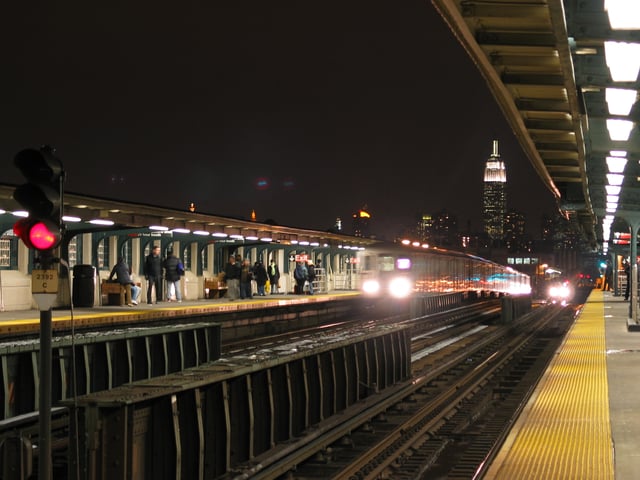
46th Street – Bliss Street subway station
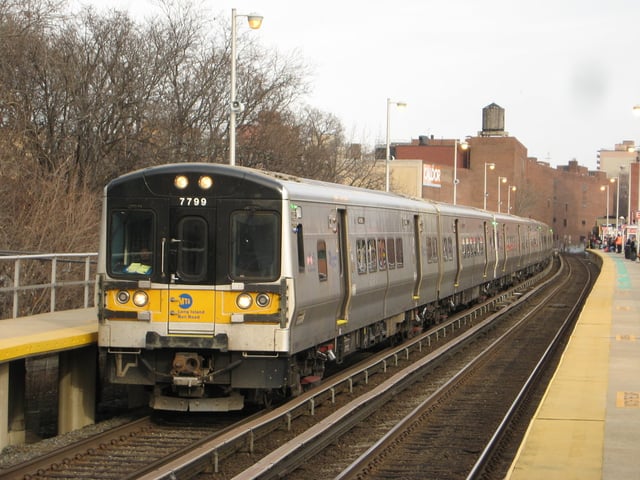
Flushing – Main Street LIRR station
Twelve New York City Subway routes traverse Queens, serving 81 stations on seven main lines. The A, G, J/Z, and M routes connect Queens to Brooklyn without going through Manhattan first. The F, M, N, and R trains connect Queens and Brooklyn via Manhattan, while the E, W, and 7/<7> trains connect Queens to Manhattan only. Trains on the M service go through Queens twice in the same trip; both of its full-length termini, in Middle Village and Forest Hills, are in Queens.[159]
A commuter train system, the Long Island Rail Road, operates 22 stations in Queens with service to Manhattan, Brooklyn, and Long Island. Jamaica station is a hub station where all the lines in the system but one (the Port Washington Branch) converge. It is the busiest commuter rail hub in the United States. There are also several stations where LIRR passengers can transfer to the subway. Sunnyside Yard is used to store Amtrak intercity and NJ Transit commuter trains from Penn Station in Manhattan. The US$11.1 billion East Side Access project, which will bring LIRR trains to Grand Central Terminal in Manhattan, is under construction and is scheduled to open in 2022; this project will create a new train tunnel beneath the East River, connecting Long Island City in Queens with the East Side of Manhattan.[160][161]
The elevated AirTrain people mover system connects JFK International Airport to the New York City Subway and the Long Island Rail Road along the Van Wyck Expressway;[162] a separate AirTrain system is planned alongside the Grand Central Parkway to connect LaGuardia Airport to these transit systems.[163][164] Plans were announced in July 2015 to entirely rebuild LaGuardia Airport itself in a multibillion-dollar project to replace its aging facilities, and this project would accommodate the new AirTrain connection.[156]
About 100 local bus routes operate within Queens, and another 20 express routes shuttle commuters between Queens and Manhattan, under the MTA New York City Bus and MTA Bus brands.[165]
Water transit

Newtown Creek with the Midtown Manhattan skyline in the background.
One year-round scheduled ferry service connects Queens and Manhattan. New York Water Taxi operates service across the East River from Hunters Point in Long Island City to Manhattan at 34th Street and south to Pier 11 at Wall Street. In 2007, limited weekday service was begun between Breezy Point, the westernmost point in the Rockaways, to Pier 11 via the Brooklyn Army Terminal. Summertime weekend service provides service from Lower Manhattan and southwest Brooklyn to the peninsula's Gateway beaches.
In the aftermath of Hurricane Sandy on October 29, 2012, massive infrastructure damage to the IND Rockaway Line (A train) south of the Howard Beach – JFK Airport station severed all direct subway connections between the Rockaway Peninsula and Broad Channel, Queens and the Queens mainland for many months. Ferry operator SeaStreak began running a city-subsidized ferry service between a makeshift ferry slip at Beach 108th Street and Beach Channel Drive in Rockaway Park, Queens, and Pier 11/Wall Street, then continuing on to the East 34th Street Ferry Landing.
In August 2013, a stop was added at Brooklyn Army Terminal.[169] Originally intended as just a stopgap alternative transportation measure until subway service was restored to the Rockaways, the ferry proved to be popular with both commuters and tourists and was extended several times, as city officials evaluated the ridership numbers to determine whether to establish the service on a permanent basis. Between its inception and December 2013, the service had carried close to 200,000 riders.[170]
When the city government announced its budget in late June 2014 for the upcoming fiscal year beginning July 1, the ferry only received a $2 million further appropriation, enough to temporarily extend it again through October, but did not receive the approximately $8 million appropriation needed to keep the service running for the full fiscal year.[171] Despite last-minute efforts by local transportation advocates, civic leaders and elected officials, ferry service ended on October 31, 2014. They promised to continue efforts to have the service restored.[172]
In February 2015, Mayor Bill de Blasio announced that the city government would begin a citywide ferry service called NYC Ferry to extend ferry transportation to communities in the city that have been traditionally undeserved by public transit.[173][174] The ferry opened in May 2017,[175][176] with the Queens neighborhoods of Rockaway and Astoria served by their eponymous routes. A third route, the East River Ferry, serves Hunter's Point South.[177]
Roads
Highways

Air Train JFK path above the Van Wyck Expressway
Queens is traversed by three trunk east-west highways. The Long Island Expressway (Interstate 495) runs from the Queens Midtown Tunnel on the west through the borough to Nassau County on the east. The Grand Central Parkway, whose western terminus is the Triborough Bridge, extends east to the Queens/Nassau border, where its name changes to the Northern State Parkway. The Belt Parkway begins at the Gowanus Expressway in Brooklyn, and extends east into Queens, past Aqueduct Racetrack and JFK Airport. On its eastern end at the Queens/Nassau border, it splits into the Southern State Parkway which continues east, and the Cross Island Parkway which turns north.
There are also several major north-south highways in Queens, including the Brooklyn-Queens Expressway (Interstate 278), the Van Wyck Expressway (Interstate 678), the Clearview Expressway (Interstate 295), and the Cross Island Parkway.
Streets
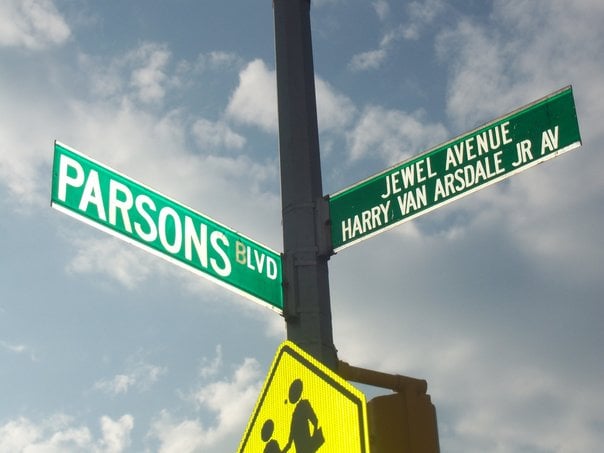
Standard cross-street signs for a single-named Boulevard and a co-named Avenue, in Queens
The streets of Queens are laid out in a semi-grid system, with a numerical system of street names (similar to Manhattan and the Bronx). Nearly all roadways oriented north-south are "Streets", while east-west roadways are "Avenues", beginning with the number 1 in the west for Streets and in the north for Avenues. In some parts of the borough, several consecutive streets may share numbers (for instance, 72nd Street followed by 72nd Place and 72nd Lane, or 52nd Avenue followed by 52nd Road, 52nd Drive, and 52nd Court), often causing confusion for non-residents.[178] In addition, incongruous alignments of street grids, unusual street paths due to geography, or other circumstances often lead to the skipping of numbers (for instance, on Ditmars Boulevard, 70th Street is followed by Hazen Street which is followed by 49th Street). Numbered roads tend to be residential, although numbered commercial streets are not rare. A fair number of streets that were country roads in the 18th and 19th centuries (especially major thoroughfares such as Northern Boulevard, Queens Boulevard, Hillside Avenue, and Jamaica Avenue) carry names rather than numbers, typically though not uniformly called "Boulevards" or "Parkways".
Queens house numbering was designed to provide convenience in locating the address itself; the first half of a number in a Queens address refers to the nearest cross street, the second half refers to the house or lot number from where the street begins from that cross street, followed by the name of the street itself. For example, to find an address in Queens, 14-01 120th Street, one could ascertain from the address structure itself that the listed address is at the intersection of 14th Avenue and 120th Street, and that the address must be closest to 14th Avenue rather than 15th Avenue, as it is the first lot on the block. This pattern doesn't stop when a street is named, assuming that there is an existing numbered cross-street. For example, Queens College is situated at 65–30 Kissena Boulevard, and is so named because the cross-street closest to the entrance is 65th Avenue.[178]
Many of the village street grids of Queens had only worded names, some were numbered according to local numbering schemes, and some had a mix of words and numbers. In the early 1920s a "Philadelphia Plan" was instituted to overlay one numbered system upon the whole borough. The Topographical Bureau, Borough of Queens, worked out the details. Subway stations were only partly renamed, and some, including those along the IRT Flushing Line (7 and <7> trains), now share dual names after the original street names.[179] In 2012, some numbered streets in the Douglaston Hill Historic District were renamed to their original names, with 43rd Avenue becoming Pine Street.[180]
The Rockaway Peninsula does not follow the same system as the rest of the borough and has its own numbering system. Streets are numbered in ascending order heading west from near the Nassau County border, and are prefixed with the word "Beach." Streets at the easternmost end, however, are nearly all named. Bayswater, which is on Jamaica Bay, has its numbered streets prefixed with the word "Bay" rather than "Beach". Another deviation from the norm is Broad Channel; it maintains the north-south numbering progression but uses only the suffix "Road," as well as the prefixes "West" and "East," depending on location relative to Cross Bay Boulevard, the neighborhood's major through street. Broad Channel's streets were a continuation of the mainland Queens grid in the 1950s; formerly the highest numbered avenue in Queens was 208th Avenue rather today's 165th Avenue in Howard Beach & Hamilton Beach. The other exception is the neighborhood of Ridgewood, which for the most part shares a grid and house numbering system with the Brooklyn neighborhood of Bushwick. The grid runs east-west from the LIRR Bay Ridge Branch right-of-way to Flushing Avenue; and north-south from Forest Avenue in Ridgewood to Bushwick Avenue in Brooklyn before adjusting to meet up with the Bedford-Stuyvesant grid at Broadway. All streets on the grid have names.
Bridges and tunnels
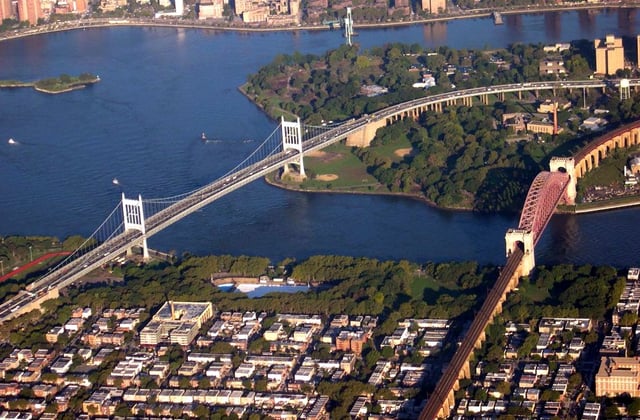
The Triborough Bridge connects Queens with Manhattan and the Bronx.
Queens is connected to the Bronx by the Bronx–Whitestone Bridge, the Throgs Neck Bridge, the Triborough Bridge (also known as the Robert F. Kennedy Bridge), and the Hell Gate Bridge. Queens is connected to Manhattan Island by the Triborough Bridge, the Queensboro Bridge, and the Queens–Midtown Tunnel, as well as to Roosevelt Island by the Roosevelt Island Bridge.
While most of the Queens/Brooklyn border is on land, the Kosciuszko Bridge crosses the Newtown Creek connecting Maspeth to Greenpoint, Brooklyn. The Pulaski Bridge connects McGuinness Boulevard in Greenpoint to 11th Street, Jackson Avenue, and Hunters Point Avenue in Long Island City. The J. J. Byrne Memorial Bridge (a.k.a. Greenpoint Avenue Bridge) connects the sections of Greenpoint Avenue in Greenpoint and Long Island City. A lesser bridge connects Grand Avenue in Queens to Grand Street in Brooklyn.
The Cross Bay Veterans Memorial Bridge, built in 1939, traverses Jamaica Bay to connect the Rockaway Peninsula to Broad Channel and the rest of Queens.[181] Constructed in 1937, the Marine Parkway–Gil Hodges Memorial Bridge links Flatbush Avenue, Brooklyn's longest thoroughfare, with Jacob Riis Park and the western end of the Peninsula.[182] Both crossings were built and continue to be operated by what is now known as MTA Bridges and Tunnels. The IND Rockaway Line parallels the Cross Bay, has a mid-bay station at Broad Channel which is just a short walk from the Jamaica Bay Wildlife Refuge, now part of Gateway National Recreation Area and a major stop on the Atlantic Flyway.
Education
Elementary and secondary education
Elementary and secondary school education in Queens is provided by a vast number of public and private institutions. Public schools in the borough are managed by the New York City Department of Education, the largest public school system in the United States. Most private schools are affiliated to or identify themselves with the Roman Catholic or Jewish religious communities. Townsend Harris High School is a Queens public magnet high school for the humanities consistently ranked as among the top 100 high schools in the United States. One of the nine Specialized High Schools in New York City is located in Queens. Located in the York College, City University of New York Campus in Jamaica, the Queens High School for the Sciences at York College, which places emphasis on both science and mathematics, ranks as one of the best high schools in both the state and the country. It is one of the smallest Specialized High Schools that requires an entrance exam, the Specialized High Schools Admissions Test. The school has a student body of around 400 students.
Postsecondary institutions
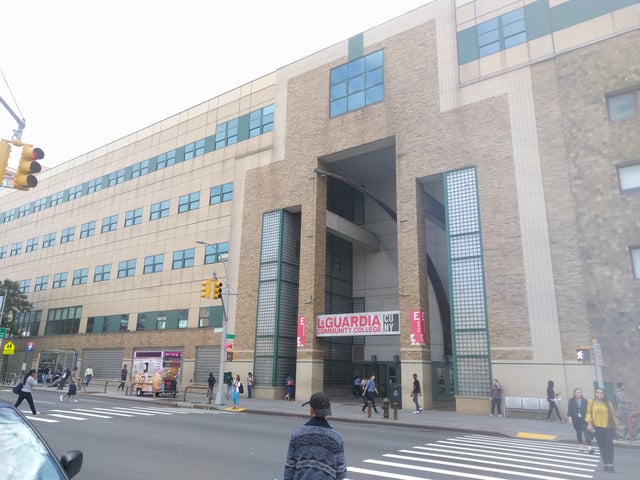
LaGuardia Community College in Long Island City, Queens.
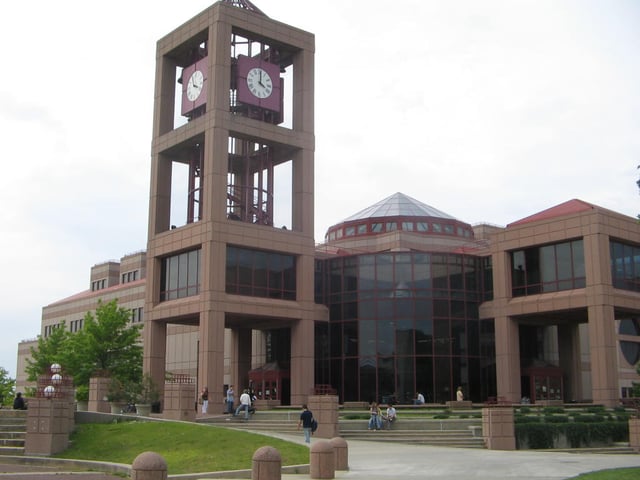
Queens College is part of the City University of New York.
LaGuardia Community College, part of the City University of New York (CUNY), is known as "The World's Community College" for its diverse international student body representing more than 150 countries and speaking over 100 languages. The college has been named a National Institution of Excellence by the Policy Center on the First Year of College and one of the top three largest community colleges in the United States.[183] The college hosts the LaGuardia and Wagner Archives.
Queens College is one of the elite colleges in the CUNY system. Established in 1937 to offer a strong liberal arts education to the residents of the borough, Queens College has over 16,000 students including more than 12,000 undergraduates and over 4,000 graduate students. Students from 120 different countries speaking 66 different languages are enrolled at the school, which is located in Flushing. Queens College is also the host of CUNY's law school. The Queens College Campus is also the home of Townsend Harris High School and the Queens College School for Math, Science, and Technology (PS/IS 499).
Queensborough Community College, originally part of the State University of New York, is in Bayside and is now part of CUNY. It prepares students to attend senior colleges mainly in the CUNY system.
St. John's University is a private, coeducational Roman Catholic university founded in 1870 by the Vincentian Fathers. With over 19,000 students, St. John's is known for its pharmacy, business and law programs as well as its men's basketball and soccer teams.
Vaughn College of Aeronautics and Technology is a private, cutting edge, degree granting institution located across the Grand Central Parkway from LaGuardia Airport. Its presence underscores the importance of aviation to the Queens economy.
York College is one of CUNY's leading general-purpose liberal arts colleges, granting bachelor's degrees in more than 40 fields, as well as a combined BS/MS degree in Occupational Therapy. Noted for its Health Sciences Programs York College is also home to the Northeast Regional Office of the Food and Drug Administration.
Queens Public Library

A branch of the Queens Public Library in Flushing.
The Queens Public Library is the public library system for the borough and one of three library systems serving New York City. Dating back to the foundation of the first Queens library in Flushing in 1858, the Queens Public Library is one of the largest public library systems in the United States. Separate from the New York Public Library, it is composed of 63 branches throughout the borough. In fiscal year 2001, the Library achieved a circulation of 16.8 million. First in circulation in New York State since 1985, the Library has maintained the highest circulation of any city library in the country since 1985 and the highest circulation of any library in the nation since 1987. The Library maintains collections in many languages, including Spanish, Chinese, Korean, Russian, Haitian Creole, Polish, and six Indic languages, as well as smaller collections in 19 other languages.
Notable people
Various public figures have grown up or lived in Queens.[184] Musicians who have lived in the borough include rappers LL Cool J, A Tribe Called Quest, Nas, Mobb Deep, Action Bronson, Onyx, Ja Rule, 50 Cent, Run–D.M.C., Nicki Minaj, Rich The Kid; Jason Griffiths Music Executive (Capitol Records) singers Nadia Ali,[185] and Tony Bennett;,[186] jazz greats Louis Armstrong and Norman Mapp both resided in Corona, rock duo Simon & Garfunkel;[187] and guitarists Scott Ian and Johnny Ramone.[188] K-pop rapper Mark Lee from the boy group NCT grew up in Queens before moving to Canada. Actors such as Adrien Brody,[189] and Lucy Liu[190] and Idina Menzel[191] have been born and/or raised in Queens. Actress Mae West also lived in Queens.[192] Writers from Queens include John Guare (The House of Blue Leaves) and Laura Z. Hobson (Gentleman's Agreement). Physician Joshua Prager was born in Whitestone.[193] Mafia boss John Gotti lived in Queens for many years.[194] Richard Feynman, a scientist who was awarded the Nobel Prize in Physics, was born in Queens and grew up in Far Rockaway.
Donald Trump, a businessman who became the 45th President of the United States, was born in Jamaica Hospital Medical Center and raised at 81-15 Wareham Place in Jamaica Estates, later moving to Midland Parkway.[195][196][197] He was preceded in the White House by former First Ladies Nancy Reagan, who lived in Flushing as a child[198] and Barbara Bush, who was born at Booth Memorial Hospital in Flushing.[199] Theodore Roosevelt, the 26th President, lived at Sagamore Hill in Oyster Bay from the mid-1880s until he died;[200] the area was considered part of Queens until the formation of neighboring Nassau County in 1899. Queens has also been home to athletes such as professional basketball player Rafer Alston[201] Basketball players Kareem Abdul-Jabbar[202][203] and Metta World Peace[204][205] were both born in Queens, as was Olympic athlete Bob Beamon.[206] Tennis star John McEnroe[207] was born in Douglaston. Hall of Fame baseball pitcher Whitey Ford grew up in Astoria.[208]
Queens has also served as a setting for fictional characters, one of the more famous being Peter Parker/Spider-Man from Marvel Comics. The character grew up in Forest Hills with his Aunt May and Uncle Ben.
See also
List of counties in New York
List of tallest buildings in Queens
National Register of Historic Places listings in Queens County, New York







